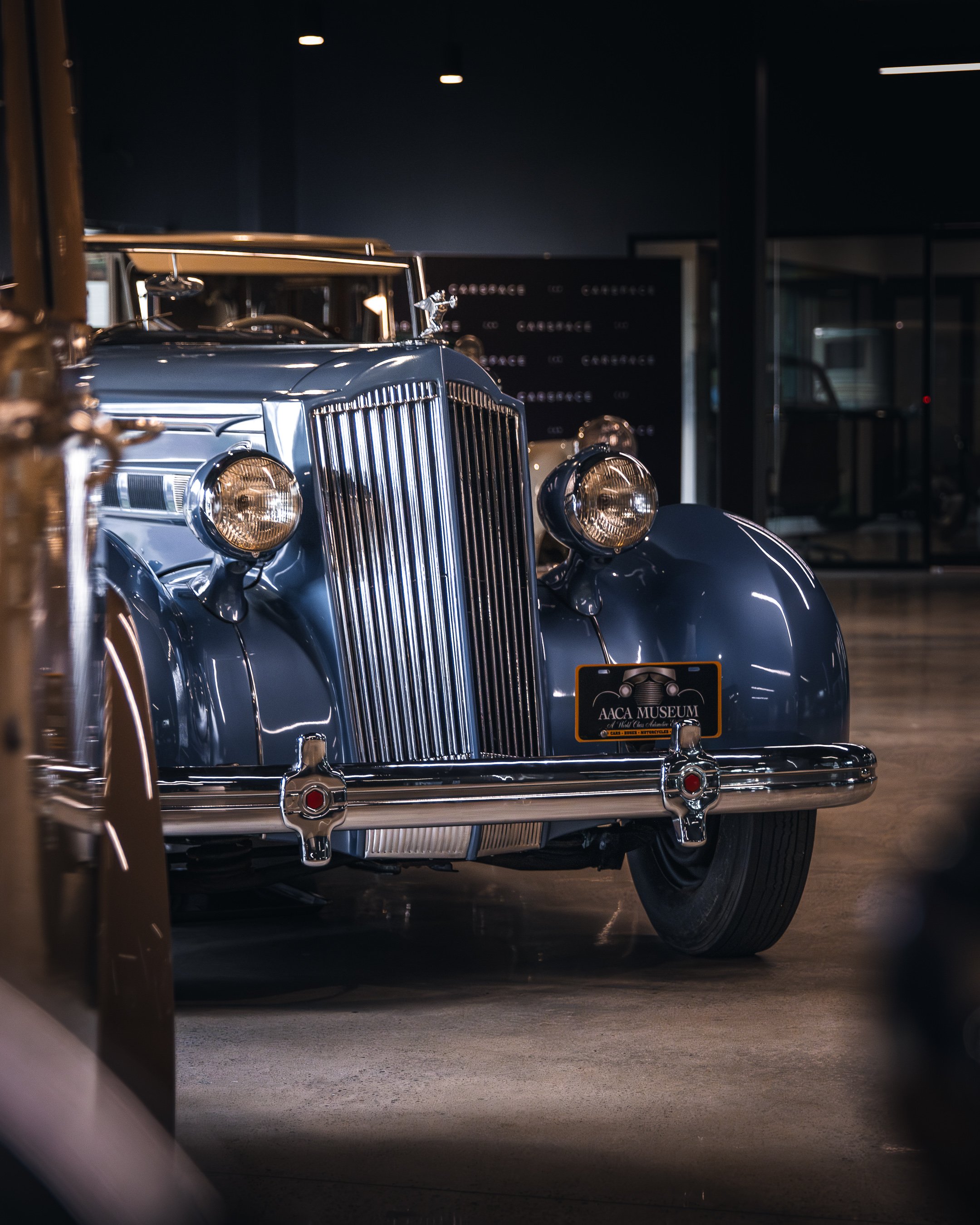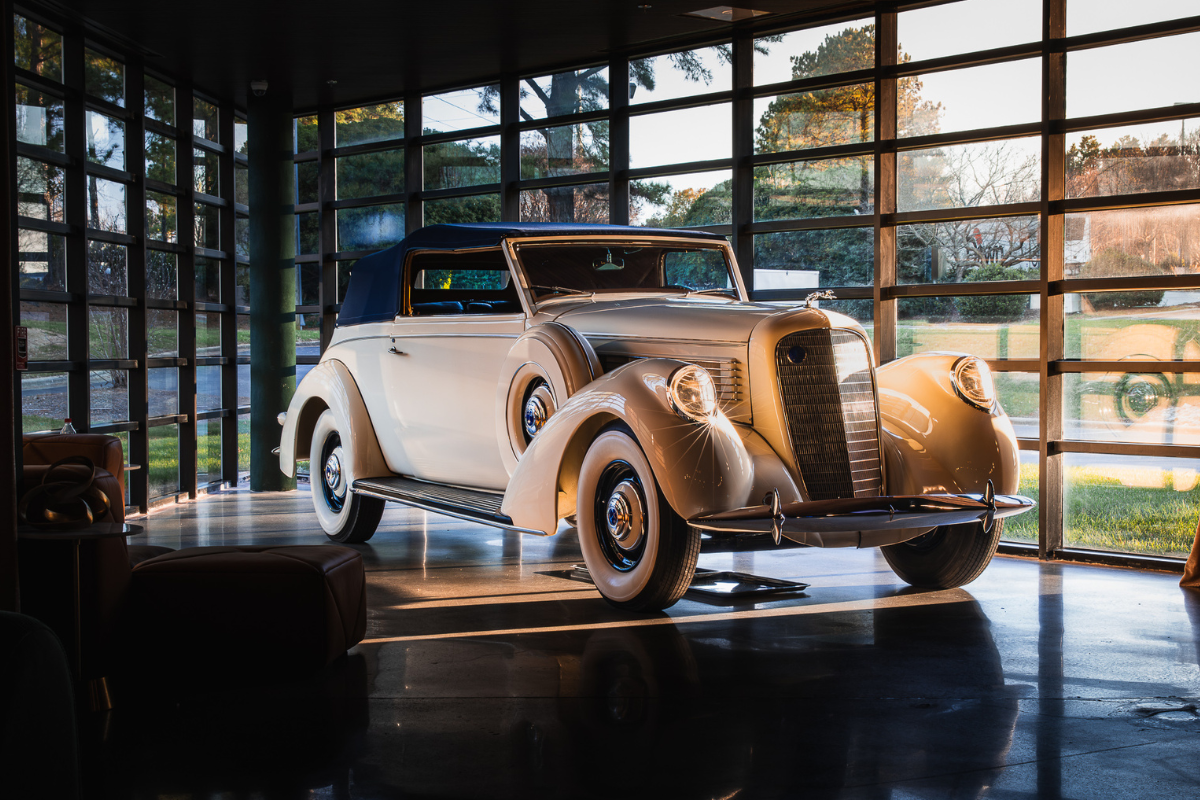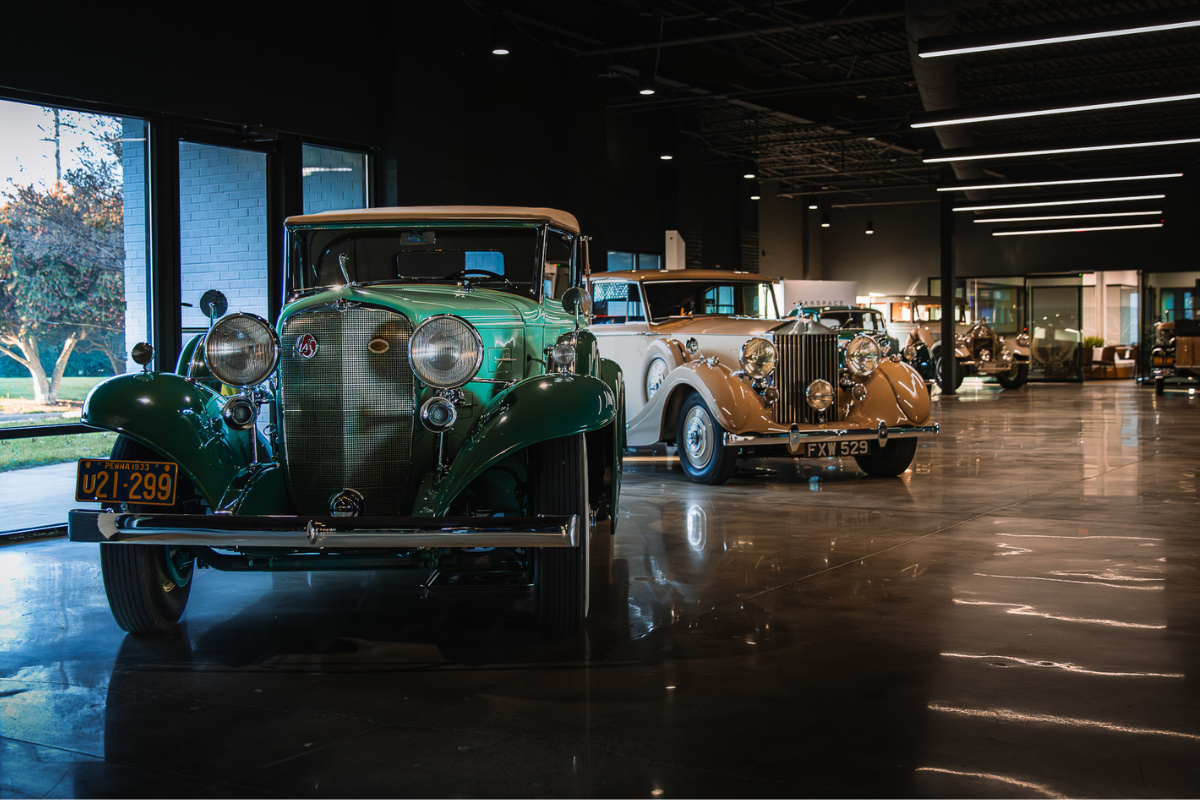| Museum Member | Free |
| Car Space Coworking Member | Free |
| Non-Members | $20 |
| Military/First Responder | $15 |
Contact for group events.
No guests under 18 without a guardian.
Currently On Exhibit

Dec 2023 - Apr 2024


From December 28th through February, immerse yourself in "A Journey Through Time: Pre-World War II Cars," a remarkable exhibition at CAR SPACE Raleigh in partnership with the Antique Automobile Club of America Museum in Hershey, PA. This event is more than a simple showcase; it's an exploration into the opulent brass era and pre-war automobiles, delving into the rich narratives and ingenious innovations that shaped the early 20th century's most iconic vehicles. Join us for a unique experience that brings to life the stories and breakthroughs of these classic treasures.
1 of 2 Surviving Lincoln Model Ks
Award Winner “Most Elegant Pre-1940 Open Automobile” 1996 Concours d’Elegance of the Eastern United States
The 1937 Lincoln K Series "Sunshine Special" was more than a presidential vehicle; it was an icon of American history. Customized for President Franklin D. Roosevelt, it was a symbol of presidential power and a witness to some of the most critical moments of the 20th century. Its design, with modifications for Roosevelt's specific needs, set the standard for all future presidential limousines. The K Series' dual role during WWII, serving both as a symbol of the presidency and as a practical vehicle in the war effort, highlighted its versatility and the enduring quality of Lincoln's engineering.
This particular pre-war Lincoln is one of only two in existence from a total of eight cars ever produced. It’s aluminum body was custom made by Brunn Coachworks of Buffalo, New York. Brunn & Company, founded in 1908 by Hermann A. Brunn, quickly rose to prominence as a distinguished custom body designer. Brunn’s background in carriage design significantly influenced the company’s fusion of classic elegance with automotive innovation. Brunn & Company was known for its connections with high-profile figures, including a notable photographic moment with President William McKinley. Among their prestigious clientele were celebrities such as J.P. Morgan, Katharine Hepburn, J.C. Penney, John Barrymore, Irving Berlin and General John Pershing , showcasing the brand's appeal to the elite. Their legacy in coachbuilding, marked by a commitment to bespoke luxury, is epitomized by the 1937 Lincoln Model K Twelve.
Discovered after years stored in a barn, it underwent a thirteen year restoration and won numerous AACA awards and the prestigious “Most Elegant Pre-1940 Open Automobile” at the 1996 Concours d’Elegance of the Eastern United States.
It is currently owned by the AACA Museum after being gifted by Jim and Sharon Raines of Charlotte, NC.
First owned by MGM Actor Robert Montgomery
Body crafted by H.J. Mulliner Coachbuilders of London
The 1939 Rolls Royce Wraith represents an era of unparalleled luxury and craftsmanship in the automotive world. As the last model introduced by Rolls-Royce before World War II, the Wraith was a limited production marvel, with only 492 vehicles made. This model encapsulated the elegance and sophistication of pre-war design, combining advanced engineering with a unique style that set it apart from its contemporaries. The Wraith was not just a car but a symbol of status and luxury, cherished by the elite and admired by all.
The body of this Rolls Royce Wraith was crafted by H.J. Mulliner & Co., a distinguished British coachbuilder known for their exquisite workmanship and bespoke designs. Established in the 1890s in London, H.J. Mulliner & Co. became synonymous with high-end, custom-built automobile bodies. Their collaboration with Rolls-Royce on the Wraith model resulted in a vehicle that was not only a marvel of engineering but also a piece of art, reflecting the opulent and discerning tastes of the era's most influential figures.
This particular vehicle was first owned by Robert Montgomery, an esteemed actor renowned for his work in film and television from the 1930s to the 1960s. Montgomery, a star in the golden era of MGM films, displayed his patriotism when he sold the car in 1940 as he entered the U.S. Navy to serve during World War II. This story adds a layer of historical significance to the vehicle, intertwining the glamour of Hollywood with the sober realities of war. The Wraith's luxurious interiors, boasting exquisite wood inlays and plush upholstery, are a testament to the era's craftsmanship, making each journey in this car an experience in opulent comfort and timeless elegance.
It is currently owned by the AACA Museum after being gifted by Lois Sinclair of Venicle, FL.
The Auburn Automobile Company manufactured the Cord luxury brand from 1929 to 1932. The L29, the first American front-wheel drive car, sat much lower than its competition due to having no rear axle. Powered by Lycoming’s 301 cubic inch 129 horsepower L-head straight 9 engine, it achieved a top speed of just over 80 miles per hour and served as the Official Pace Car of the 1930 Indianapolis 500 race.
The Cord L-29 was a beacon of innovation and style. Its front-wheel-drive system was a groundbreaking feature that provided an improved ride and lower profile, revolutionizing American automotive design. The Cord's sweeping fenders and elegant lines made it a star in its own right, with appearances in numerous films and at high-profile events. It was a car that represented the boldness and creativity of the era, an artifact of the roaring twenties' spirit of adventure and opulence. The Cord was more than just a mode of transportation; it was a statement, a declaration of sophistication, and a testament to the era's boundless optimism and ambition.
It is currently owned by the AACA Museum after being gifted by MBNA America.
Award Winner 1999 Pebble Beach Concours d’Elegance
First Owned by Paramount Studios
Widely regarded as one of America’s finest automobile manufacturers, Pierce-Arrow first produced cars in 1901. Pierce-Arrow pioneered the use of aluminum components, power steering, and multi-valve engines. This 7 passenger town car features fender mounted headlights flanking a grill plated in “German silver”, and interior hardware plated in 24 carat gold. Power is delivered by a 414 cubic inch 6 cylinder “T” head 24 valve engine working through a 3 speed manual transmission.
The Pierce Arrow's connection to Frank Lloyd Wright added a layer of artistic and cultural significance to its already prestigious reputation. Wright's customizations and his use of the vehicle in conjunction with his architectural works illustrated the car's role not just in transportation but in the broader landscape of American design and innovation. The Pierce Arrow was a moving testament to the era's craftsmanship and luxury. Its broad, imposing grille and elegant silhouette made it a rolling piece of art, a mobile embodiment of the opulence and grandeur that defined the late 1920s.
This particular Pierce-Arrow was originally owned by Paramount Studios and transported film stars to and from their Los Angeles homes during a time when Mae West and Bing Crosby were acting in some of their most definitive roles. It is currently owned by the AACA Museum after being gifted by MBNA.
The Packard Convertible Sedan was not just a car but a fixture of the golden age of Hollywood. Its sleek design and luxurious appointments made it the vehicle of choice for the era's biggest stars. The Packard's appearances in films and at glamorous events cemented its status as a symbol of elegance and high society. It was a car that represented the pinnacle of American luxury, a tangible connection to a world of red carpets, movie premieres, and the allure of the silver screen.
James Ward Packard was known for building some of the most powerful and prestigious automobiles of the 1930s, and in 1935 he entered the mid-priced market with the Model 120. Powered by a 8 cylinder 120 horsepower engine, this 4-door, 5-passenger Convertible Sedan could reach 60 miles per hour in under 20 seconds with a top speed of 85 miles per hour.
This particular car was one of 55,000 sold in 1936. It is currently owned by the AACA Museum after being gifted by William J Cammack of Alexandria, VA.
The 1933 LaSalle represented the vision and artistry of Harley Earl, a legend in automotive design. Earl's influence extended far beyond the LaSalle's iconic grille; he revolutionized the industry with his concept of annual model changes, keeping Cadillac at the forefront of style and luxury. The LaSalle was not just a car; it was a fashion statement, a moving testament to the era's aesthetic and technological advancements. Its streamlined shape and elegant form captured the spirit of the 1930s, making it a favorite among the stylish and sophisticated.
LaSalle was manufactured and marketed by Cadillac from 1927 to 1941 as the second most prestigious marque offered by General Motors. In an era when automotive brands were somewhat restricted to building a specific car per model year, Cadillac believed that developing a “companion” marque at a lower price point could fill gaps in the portfolio.
It is currently owned by the AACA Museum after being gifted by Walter C. Van Nuys II of Selinsgrove, PA.
| Museum Member | Free |
| Car Space Coworking Member | Free |
| Non-Members | $20 |
| Military/First Responder | $15 |
Contact for group events.
No guests under 18 without a guardian.
Monday, Tuesday & Wednesday
5:00 PM ― 9:00 PM
Friday & Saturday
5:00 PM ― Midnight
Live Music Friday & Saturday 9:00 PM - 11:30 PM
Closed Thursday & Sunday for Private Events